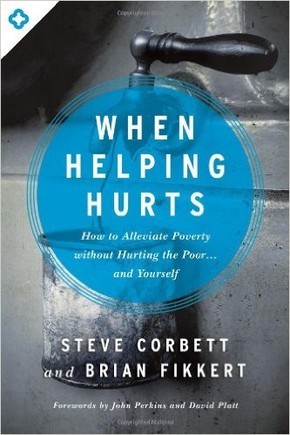Undoubtedly, Christians in America should be commended for the growth of missions in the last two to three decades, and specifically the growth in short-term mission trips (STMs). In 1989, there were 120,000 American “short-term missionaries.” This number has exploded to 2.2 million at a cost of $1.6 billion in 2006.[1] This statistic comes from authors Steve Corbett and Brian Fikkert in their somewhat controversial book, When Helping Hurts: How to Alleviate Poverty without Hurting the Poor … and Yourself. The natural question that the authors consider—and one that we all should as well—is whether we are being good stewards of God’s money and resources with each STM.
 Are STMs good? Yes, of course they are! God has done wonderful and miraculous things through STMs. Essentials such as water wells and key structures have been built. The gospel has been spread and lives have been given to the Lord. The question is not about whether good has come from STMs, but whether we (a) could make more effective use of those same funds and (b) cause some level of “hurt” along with good.
Are STMs good? Yes, of course they are! God has done wonderful and miraculous things through STMs. Essentials such as water wells and key structures have been built. The gospel has been spread and lives have been given to the Lord. The question is not about whether good has come from STMs, but whether we (a) could make more effective use of those same funds and (b) cause some level of “hurt” along with good.
Good Stewardship of God’s Resources
If we send 10-20 people on an STM, the total cost would be around $20,000 to $40,000.[2] Consider what we could do with those funds for the people we seek to help if we didn’t go? Could we find a local contractor who could build the well (infusing funds into the local economy), who would likely do a better job (unless we have some very seasoned contractors go), and still have plenty of money left over to fund the salary of a local or indigenous pastor/missionary who will stay there over a long period of time? According to Corbett and Fikkert, “a highly respected organization” that “equips and manages national evangelists across the continent of Africa” can do so for just $1,540 per missionary, per year![3] When presented with the math, we should pause and (re)consider.
The authors give the following illustration: If a church in Switzerland offered either to send a team of missionaries to run a VBS at a 130 person church in rural Georgia, or give them a check for $25,000, which would the church choose? This would be a no-brainer—they’d definitely take the check! They’d spend $20,000 on finishing an addition they had been trying to build for the last five years, and the remaining $5,000 would double their VBS budget and they could have ample resources to do an awesome VBS. And this would then alleviate the cultural and language barriers from having a team from outside try to re-contextualize to rural Georgia. Instead, the local church that already knows the specific needs of the children there would likely be more effective in reaching their local community. I would venture to guess that when faced with the same decision, many of us would make the same choice.
In other words, whether sending or going on STMs, we must factor in the actual capital cost as we go. And I absolutely do not mean pulling out a spreadsheet to figure out whether one saved life is worth $20,000. Of course it is! The real question is whether we can accomplish the same task, or even more, with the same $20,000. Are we strategizing and thinking through the best way to make the resources we have as effective as possible?
Hurting vs. Helping?
In what possible way can building a well, or running a VBS, or doing Bible study training do more harm than good? It seems to me that these are inherently good things. What if we were to satisfy the above financial concerns and run an effective, efficient STM? My initial thought on this was that it would be a help and blessing. Corbett and Fikkert, however, note that there are often unforeseen ramifications of these STMs, even if they were to be financially efficient.
Take into consideration an example that the authors give about STMs in Latin America. One of the many activities a mission organization that does long-term work with local people in Latin America is training indigenous leaders to do children’s Bible studies. After a STM comes through, children stop going to the local Bible studies. Why? Because the local leader doesn’t have the fancy materials and crafts that the STMs have. What effect do we have when we import the kinds of resources we are used to, but for only a limited time (very nature of STMs). Moreover, we want to do a bang up job and do even more because we want to give the recipient our very best.
This is just one of the very many examples given in the book of how the way we do missions actually hurts the people that we—with every good intention—are trying to help.
If you’re wondering if I’m advocating to get rid of STMs, I’d like to unequivocally state that I am for STMs. I’m only suggesting that we take a moment to think carefully about how to do each STM.
If you’re planning a STM or going on one, here are some general tips that might be helpful to consider:
- Think carefully how to use your God-given resources in a way that is sustainable to the people you are providing help.
- Is the trip cost efficient? In other words, could the same funds (or less) be used to accomplish the same goals, or even more? Perhaps one could send just a two or three member team to mobilize the local assets already in place (from contractors to pastors/missionaries, etc.) to ensure that the project is carried out, but more importantly, to build a long-term relationship with the recipients.
- Partner with the local, indigenous ministry folks already there, and listen carefully to what the challenges are. Be willing to listen and learn first. Consider the example of the VBS mission trip above. There are long term consequences that I think most of us (including me) would not have thought of on our own.
- Consider the STM as only a start to a long-term relationship. Colbertt and Fikkert suggest that at the outset, plan on making two trips, the second being at least a year after the first. Relationships are key, and two weeks is likely not enough to build a long standing relationship.
- Finally, consider doing what Colbert and Fikkert call “vision trips” instead of STMs. The authors—rightly, I think—consistently state: “It is not about us. It is about them!”[4] If your primary goal is to see first hand what the conditions are in a poor community in order to help those who are in desperate need of the gospel, take the time to go, see, listen, and learn about the community you want to help. Often times STM reports are filled with less about the long term impact on the community they visited, and more about the personal blessing and impact that was made on the one who went. And, if what you are really doing is a vision trip (meant more for your growth rather than theirs), not only call it that, but consider financing the majority of the cost yourself. This will also help for one to be personally vested in the trip and the long-term impact of it.
If you are considering missions in any form (from going, to giving, to everything in-between), I’d encourage you to pick up a copy of When Helping Hurts and give it a good read. It’s less than $9 on Amazon, and here’s even a link for your convenience.
You may not agree with all that the authors state, but it will help you consider more carefully how you can best be a help to others and fulfill the Great Commission. It did for me.
 Biola University
Biola University
.jpg)


.jpg)